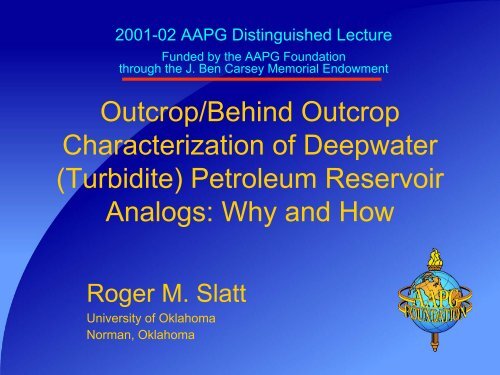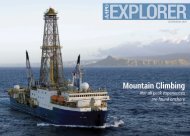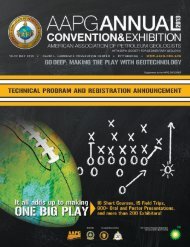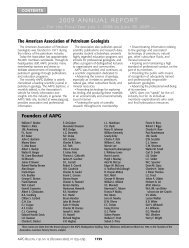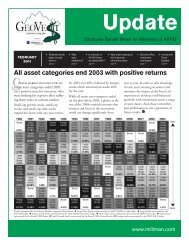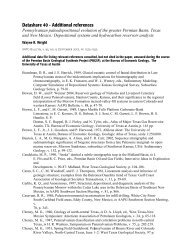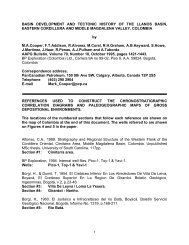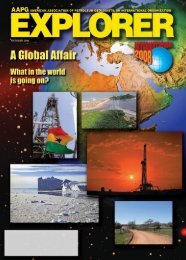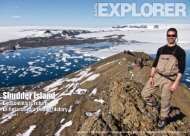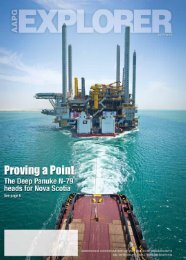Outcrop/Behind Outcrop Characterization of Deepwater (Turbidite ...
Outcrop/Behind Outcrop Characterization of Deepwater (Turbidite ...
Outcrop/Behind Outcrop Characterization of Deepwater (Turbidite ...
Create successful ePaper yourself
Turn your PDF publications into a flip-book with our unique Google optimized e-Paper software.
2001-02 AAPG Distinguished Lecture<br />
Funded by the AAPG Foundation<br />
through the J. Ben Carsey Memorial Endowment<br />
<strong>Outcrop</strong>/<strong>Behind</strong> <strong>Outcrop</strong><br />
<strong>Characterization</strong> <strong>of</strong> <strong>Deepwater</strong><br />
(<strong>Turbidite</strong>) Petroleum Reservoir<br />
Analogs: Why and How<br />
Roger M. Slatt<br />
University <strong>of</strong> Oklahoma<br />
Norman, Oklahoma
© 2001 The American Association <strong>of</strong><br />
Petroleum Geologists and Roger M. Slatt<br />
No slides, figures, text or other matter<br />
contained herein may be reproduced without<br />
the written permission <strong>of</strong> both the American<br />
Association <strong>of</strong> Petroleum Geologists and<br />
Roger M. Slatt
ENGINEERING DEFINITION: Drilling a well <strong>of</strong>fshore into<br />
a basin fill in present-day water depths greater than 500m<br />
(1500ft) above the mud line (ocean floor).
<strong>Deepwater</strong> (>500m) discovered reserves<br />
1978<br />
1980<br />
Cumulative Gas<br />
Cumulative Oil/Cond.<br />
Cumulative BBOE in Ultra-Deep<br />
Water (>2000m)<br />
Portion <strong>of</strong> BBOE<br />
Developed or under<br />
development<br />
1982<br />
1984<br />
1986<br />
1988<br />
Year<br />
1990<br />
1992<br />
1994<br />
1996<br />
7 BBOE per year<br />
1998<br />
Gas<br />
Oil<br />
Developed<br />
UDW<br />
2000<br />
50<br />
40<br />
30<br />
20<br />
10<br />
0<br />
BBOE<br />
Discoveries<br />
mainly from:<br />
Gulf <strong>of</strong> Mexico,<br />
<strong>of</strong>fshore W.<br />
Africa and<br />
Brazil, N. Sea,<br />
SW shelf<br />
Australia, SE<br />
Asia<br />
< 25% Developed<br />
or In Development<br />
Source:<br />
Various
<strong>Deepwater</strong> Discovered Reserves<br />
>500m water depth<br />
as <strong>of</strong> Sept. 2001<br />
4<br />
3,0<br />
10<br />
8,6<br />
US GoM<br />
Taumalipas<br />
& Campeche<br />
Recoverable<br />
Resources in BBOE<br />
(green= oil, red = gas)<br />
Scotian &<br />
Jeanne D’Arc<br />
Trinidad<br />
Brazil<br />
Faroes<br />
White Zone<br />
WoS<br />
Morocco<br />
0,9<br />
10,9<br />
12<br />
0,5<br />
12,4 13<br />
3.6 3,0<br />
Mid-Norway<br />
0,6<br />
Egypt<br />
Nigeria<br />
Eq. Guinea<br />
Gabon<br />
Congo<br />
Angola<br />
S. Africa<br />
Italy<br />
2.0<br />
So. Caspian<br />
2,0 0,9<br />
1,8<br />
2.7<br />
Tanzania<br />
Mozambique<br />
E. India<br />
Total Discovered<br />
57 BBOE<br />
37 BBO + 120 TCF<br />
6,8<br />
7<br />
0,1<br />
NWS & ZOCA<br />
Sakhalin<br />
NW & SE Borneo<br />
Taranaki<br />
Areas <strong>of</strong> Prospective <strong>Deepwater</strong><br />
and Ultra-<strong>Deepwater</strong> Basins<br />
Data Sources: Pettingill (1999), various others
GEOLOGIC DEFINITION: Clastic sediments transported beyond the shelf<br />
edge into deep water by sediment gravity flow processes and deposited on<br />
the continental slope and in the basin. They are later buried and become part<br />
<strong>of</strong> a basin fill: Engineering and geologic ‘deep water’ are usually the same.<br />
Sp<br />
SIX RESERVOIR TYPES
Distal levee or<br />
TYPE III<br />
OVERBANK<br />
OVERBANK SLUMP<br />
SUBMARINE CHANNEL<br />
SYSTEM<br />
AGGRADING CHANNEL-LEVEE<br />
COMPLEX<br />
Splay<br />
CHANNEL PROXIMAL<br />
LEVEE<br />
CHANNEL<br />
LEVEE<br />
(Roberts and Compani,<br />
1996)
3D SEISMIC HORIZON SLICE<br />
Offshore Angola<br />
next picture<br />
(Provided by Kolla)
3D Seismic line, <strong>of</strong>fshore Angola<br />
Black = positive seismic reflection<br />
Purple = negative seismic reflection<br />
Kolla et al., 2001
3D Seismic line, <strong>of</strong>fshore Angola<br />
Black = positive seismic reflection<br />
Purple = negative seismic reflection<br />
Discovery Well<br />
Kolla et al., 2001
APPRAISAL & DEVELOPMENT<br />
• HOW BIG IS THE RESERVOIR?<br />
• HOW WILL THIS RESERVOIR STYLE PERFORM?<br />
• HOW WIDELY MUST WE SPACE OUR<br />
EXPENSIVE DEVELOPMENT WELLS?<br />
• SHOULD WE DRILL A VERTICAL, SLANT, OR<br />
HORIZONTAL WELL??<br />
• HOW CAN WE FAST-TRACK DEVELOPMENT OF<br />
THIS RESERVOIR?<br />
• WHAT WENT WRONG?
HOW CAN OUTCROPS HELP ANSWER<br />
THOSE TOUGH Con QUESTIONS??<br />
BUILDING A SCALED GEOLOGIC MODEL<br />
FROM OUTCROPS:<br />
•Sheet Sandstone Reservoirs<br />
•Leveed Channel Sandstone Reservoirs<br />
Lets study the Cretacous Lewis Shale in Wyoming!!
TOOLS AND TECHNIQUES FOR<br />
OUTCROP CHARACTERIZATON<br />
STANDARD RECENT ADDITIONS<br />
•Brunton Compass •Photomosaics on Workstation<br />
•Hand Lens •<strong>Outcrop</strong> gamma-ray/sonic logs<br />
•Jacobs Staff •<strong>Behind</strong>-outcrop logging/coring<br />
•Tape Measure •Ground Penetrating Radar (GPR)<br />
•Rock Hammer •Global Positioning System (GPS)<br />
•Camera •Ultra-shallow seismic behind<br />
outcrop<br />
•<strong>Outcrop</strong> Minipermeameter<br />
•3D Imaging
West<br />
Cretaceous Lewis Shale, Wyoming<br />
“Bashful outcrops”<br />
12<br />
Spine I<br />
S1 and S2 are continuous Lewis sheet sandstones<br />
CC is Lewis leveed channel complex on Spine I<br />
F is shallow marine Fox Hills<br />
North
West<br />
Cretaceous Lewis Shale, Wyoming<br />
Spine I<br />
S1 and S2 are continuous Lewis sheet sandstones<br />
CC is Lewis leveed channel complex on Spine I<br />
F is shallow marine Fox Hills<br />
North
Sheet Sandstones:<br />
Laterally continuous<br />
for miles: i.e. good<br />
potential reservoir<br />
facies; individual<br />
sandstone intervals<br />
are separated by<br />
shales.<br />
(Witton, 1999)<br />
Lith<strong>of</strong>acies A<br />
Sheet Sandstones
West<br />
Cretaceous Lewis Shale, Wyoming<br />
Spine I<br />
Laterally continuous shales in between<br />
Laterally continuous sandstones<br />
S1 and S2 are continuous Lewis sheet sandstones<br />
CC is Lewis leveed channel complex on Spine I<br />
F is shallow marine Fox Hills<br />
North
West<br />
Cretaceous Lewis Shale, Wyoming<br />
Spine I<br />
S1 and S2 are continuous Lewis sheet sandstones<br />
CC is Lewis leveed channel complex on Spine I<br />
F is shallow marine Fox Hills<br />
North
Channel-fill #1<br />
Sandstone<br />
Spine I<br />
(yellow line is app. 450m on ground; 120m <strong>of</strong> strat. section)<br />
Well-------<br />
#2 #3 #4 #5 #6<br />
10 Channel-fill sandstones, each separated<br />
by shale/mudstone breaks:i.e. discontinuous<br />
reservoirs; not so easy to develop as reservoirs
<strong>Behind</strong>-outcrop drilling for logs and core
Gamma Ray<br />
Where’s the<br />
10 sands??<br />
Core<br />
GR<br />
Bulk Density<br />
Sonic Dt<br />
Neutron Porosity<br />
Core Porosity<br />
CSM Strat<br />
Test #61<br />
Core and<br />
Log Data<br />
<strong>Outcrop</strong><br />
Subcrop
Channel-fill #1<br />
Sandstone<br />
Well-------<br />
#2 #3 #4 #5 #6<br />
Where did the Channel-fill #1 Sandstone go?? Meander loop <strong>of</strong><br />
sinuous channel??
Channel-fill #1<br />
Sandstone<br />
Well-------<br />
#2 #3 #4 #5 #6<br />
Where did the Channel-fill #1 Sandstone go?? Meander loop <strong>of</strong><br />
sinuous channel??
Thin-bedded,<br />
extra-channel<br />
or levee<br />
facies<br />
Rain gulley
Spine I, Lewis Shale<br />
Sinuosity not<br />
shown in model<br />
#4<br />
#3<br />
Channel-fill #1<br />
Sandstone -----------<br />
Width <strong>of</strong> channel<br />
Complex app. 500m<br />
#6 #7 #8<br />
#9<br />
#10<br />
#2<br />
#5<br />
CSM Strat Test well<br />
Sheet sandstones<br />
Thin levee beds<br />
not shown in<br />
model<br />
Channel complex
Laterally discontinuous<br />
channel-fill sandstone<br />
Channel-fill #1<br />
Sandstone<br />
(150m across in outcrop)
Channel-fill #1 Sandstone; oblique view<br />
across channel-fill<br />
X-bedded sands<br />
Massive sands w/ fluid escape structures<br />
Red = shale clast cong. Brown = sandy debrites
Cross-bedded sandstone
Shale clast conglomerate(debrite)<br />
Interbedded turbidites and debrites<br />
<strong>Turbidite</strong>
Laterally discontinuous<br />
channel-fill sandstone<br />
Channel-fill #1<br />
Sandstone<br />
(150m across in outcrop)
Margin <strong>of</strong> Channel Sandstone #1<br />
Ground-penetrating radar (GPR) line across channel margin<br />
showing sharp channel boundary and internal channel-slump<br />
features<br />
(Young et al,, 1999)
15<br />
ft<br />
Complex Channel margin<br />
S N<br />
P5<br />
Station 26<br />
0<br />
6.5<br />
9.8<br />
13<br />
16<br />
Channel margin is slumped,<br />
with channel sand injections<br />
into adjacent thin-beds<br />
Approximate depth<br />
(ft)<br />
H:V ~ 1:1
Thin bedded Sandstones/Mudstones<br />
Slumped<br />
beds<br />
Channel Sandstone
Thin bedded Sandstones/Mudstones<br />
Slumped<br />
beds<br />
Channel Sandstone<br />
No communication<br />
across slumped zone<br />
in reservoir analogs
Spine I, Lewis Shale<br />
#4<br />
#3<br />
Channel-fill #1<br />
Sandstone -----------<br />
Width <strong>of</strong> channel<br />
Complex app. 500m<br />
#6 #7 #8<br />
#9<br />
#10<br />
#2<br />
#5<br />
CSM Strat Test well<br />
Sheet sandstones<br />
Channel complex
Spine I, Lewis Shale<br />
#4<br />
#3<br />
Channel-fill #1<br />
Sandstone -----------<br />
Width <strong>of</strong> channel<br />
Complex app. 500m<br />
#6 #7 #8<br />
#9<br />
#10<br />
#2<br />
#5<br />
CSM Strat Test well<br />
Sheet sandstones<br />
Channel complex
Spine I, Lewis Shale<br />
#4<br />
#3<br />
Channel-fill #1<br />
Sandstone -----------<br />
Width <strong>of</strong> channel<br />
Complex app. 500m<br />
#6 #7 #8<br />
#9<br />
#10<br />
#2<br />
#5<br />
CSM Strat Test well<br />
Sheet sandstones<br />
Channel complex<br />
Complex channel<br />
margin
3D Seismic line, <strong>of</strong>fshore Angola<br />
Black = positive seismic reflection<br />
Purple = negative seismic reflection<br />
Multiple channel sandstones separated<br />
by mudstones<br />
Sheet Sandstones separated by mudstones<br />
Kolla et al., 2001
3D Seismic line, <strong>of</strong>fshore Angola<br />
Black = positive seismic reflection<br />
Purple = negative seismic reflection<br />
Discovery Well<br />
Kolla et al., 2001
Well<br />
Black = positive seismic reflection<br />
Purple = negative seismic reflection<br />
Kolla et al., 2001
Con<br />
HOW CAN OUTCROPS HELP ANSWER<br />
THOSE TOUGH QUESTIONS??<br />
BUILDING A SCALED GEOLOGIC MODEL<br />
FROM OUTCROPS:<br />
•Thin-bedded levee reservoirs<br />
Lets study the Miocene Mt. Messenger Formation<br />
in New Zealand!!
Distal levee or<br />
TYPE III<br />
OVERBANK<br />
OVERBANK SLUMP<br />
SUBMARINE CHANNEL<br />
SYSTEM<br />
AGGRADING CHANNEL-LEVEE<br />
COMPLEX<br />
Splay<br />
CHANNEL PROXIMAL<br />
LEVEE<br />
CHANNEL<br />
LEVEE<br />
(Roberts and Compani,<br />
1996)
Miocene Mt. Messenger Formation, Taranaki Basin,<br />
New Zealand: Cliff is 250m high and several km long<br />
Two<br />
Wells<br />
H.R.<br />
Seismic<br />
PHOTOMOSAICS FROM HELICOPTER; WELLS; CORES; LOGS; HIGH-<br />
RESOLUTION SHALLOW SEISMIC; MEASURED SECTIONS
Depositional interval or bed scale
Pleistocene-----------<br />
(brown)<br />
--D<br />
C = channel fill (upward dip decrease); P = proximal<br />
levee (high & variable angle dips); D = distal levee;<br />
C<br />
P
Distal levee bed sets (lower & uniform dip angles)
<strong>Behind</strong>outcrop<br />
dipmeter<br />
logs (by<br />
Schlumberger)<br />
Channel<br />
fill<br />
Distal levee/<br />
overbank<br />
Proximal<br />
levee<br />
(Slatt et al.,<br />
1998)
Levee beds<br />
3D Seismic line, <strong>of</strong>fshore Angola<br />
Black = positive seismic reflection<br />
Purple = negative seismic reflection<br />
Multiple channel sandstones separated<br />
by mudstones<br />
Levee beds<br />
Sheet Sandstones separated by mudstones<br />
Kolla et al., 2001
Well<br />
Black = positive seismic reflection<br />
Purple = negative seismic reflection<br />
Kolla et al., 2001
L Sand, Ram/Powell Field, Gulf <strong>of</strong> Mexico: comprises channel,<br />
proximal, & distal levee facies.<br />
West Ram/Powell Field<br />
East<br />
4.0 s<br />
4.5 s<br />
Tertiary Cretaceous Unconformity<br />
J sand L sand<br />
3363 ft<br />
N sand<br />
M sand<br />
(Clemenceau et al., 2000)
west east<br />
channel<br />
wet<br />
datum base <strong>of</strong> sand<br />
Ram Powell ‘L’ Sand<br />
proximal levee distal levee<br />
100 ft<br />
low resistivity gas pay<br />
(Clemenceau et al, 2000)<br />
2 ohms
west east<br />
channel<br />
wet<br />
datum base <strong>of</strong> sand<br />
Ram Powell ‘L’ Sand<br />
Inferred complex<br />
channel margin<br />
proximal levee distal levee<br />
100 ft<br />
low resistivity gas pay<br />
(Clemenceau et al, 2000)<br />
2 ohms
west east<br />
channel<br />
wet<br />
datum base <strong>of</strong> sand<br />
Ram Powell ‘L’ Sand<br />
Inferred complex<br />
channel margin<br />
proximal levee distal levee<br />
100 ft<br />
low resistivity gas pay<br />
(Clemenceau et al, 2000)<br />
2 ohms
(Clemenceau et al., 2000)
Amplitude<br />
proximal levee<br />
Channel<br />
high<br />
low<br />
3 miles<br />
A<br />
B<br />
C<br />
A-1(horizontal)<br />
Seismic line Fig. 5<br />
Ram Powell ‘L’ Sand<br />
E<br />
D<br />
GOC<br />
A<br />
B<br />
C<br />
D<br />
E<br />
L-1 LKO<br />
wet well<br />
A5<br />
A8st1<br />
A8st2<br />
A17<br />
957-1st2<br />
well test<br />
distal<br />
levee-overbank<br />
Drilling Strategy: Horizontal well in proximal levee beds, parallel to channel:<br />
“Well performance N exceeded expectations with a peak flow rate <strong>of</strong> 105mmcfgd<br />
and 9600 bopd”<br />
100 ft contour interval<br />
(Clemenceau et al, 2000)
WHAT IF YOU DON’T HAVE<br />
SEISMIC????<br />
BOREHOLE IMAGE LOGS WILL ALLOW YOU TO<br />
DIFFERENTIATE FACIES FOR VOLUMETRICS<br />
AND DRILLING STRATEGY (i.e. conventional<br />
well logs won’t differentiate facies with any degree<br />
<strong>of</strong> certainty)<br />
-Wellbore and behind-outcrop borehole image logs<br />
(STAR TM and FMI tm ) verify this in Lewis Shale<br />
and Mt. Messenger!!<br />
TM Baker-Hughes<br />
tm Schlumberger
Borehole<br />
Image<br />
Log,<br />
Lewis Sh.<br />
Debrites<br />
and<br />
<strong>Turbidite</strong>s =<br />
Channel -fill<br />
sandstones<br />
(Witton, 2000)
Borehole<br />
Image<br />
Log,<br />
Lewis Sh.<br />
<strong>Turbidite</strong>s<br />
only =<br />
Sheet<br />
Sandstones<br />
(Witton, 2000)
Levee beds<br />
from Mt.<br />
Messenger<br />
Fm. New<br />
Zealand
Well<br />
Well
Well<br />
Well
YET ANOTHER USE OF OUTCROPS<br />
Con<br />
•3D GEOLOGIC MODELING FOR<br />
VISUALIZATION, RESERVOIR<br />
PERFORMANCE PREDICTION &<br />
WELL PLACEMENT<br />
Lets study the Penn. Jackfork Group in Arkansas!!
Dipping sheet<br />
sands (colors)<br />
separated<br />
by shales<br />
Gulf <strong>of</strong> Mexico stacked sheet sand reservoirs<br />
(Kendrick, 2000)
CAVE<br />
3D Seismic data<br />
volume<br />
Person<br />
Dorn et.al, 2001<br />
Walk-in CAVE’s are excellent, but expensive!!
GEOLOGIC MODELING AREA, ARKANSAS: THE INEXPENSIVE<br />
CAVE IS CALLED AN OUTCROP!!!<br />
55
OUTCROP GEOLOGIC MODELING AREA, ARKANSAS<br />
55<br />
A
OUTCROP GEOLOGIC ‘RESERVOIR’ MODEL<br />
‘UNCONFORMITY TOPSEAL’<br />
‘Sealing<br />
A B C<br />
Shale’<br />
‘RESERVOIR SANDSTONES’<br />
‘OIL-WATER CONTACT’<br />
OUTCROP ‘A’<br />
“Imagination is more powerful than knowledge”<br />
Albert Einstein
A<br />
Zone Net/Gross Por.(%) Perm.(md) Sw (%)<br />
A 0.70 29 1000 20<br />
B 0.40 26 300 20<br />
C 0.95 29 1000 20<br />
D 0.96 30 2000 20<br />
Oil/water contact<br />
C SHALE<br />
D<br />
B<br />
FAULT<br />
GEOLOGIC<br />
RESERVOIR<br />
MODEL FOR<br />
SIMULATION:<br />
Dipping sandstones<br />
with unconformity<br />
topseal; Layers<br />
separated by<br />
sealing shales
Zone Net/Gross Por.(%) Perm.(md) Sw (%)<br />
A 0.70 29 1000 20<br />
B 0.40 26 300 20<br />
C 0.95 29 1000 20<br />
D 0.96 30 2000 20<br />
Oil/water<br />
contact<br />
GEOLOGIC<br />
RESERVOIR<br />
MODEL FOR<br />
SIMULATION:<br />
Dipping sandstones<br />
with unconformity<br />
topseal; Layers<br />
separated by<br />
sealing shales
A<br />
Oil/water contact<br />
C<br />
B<br />
WELL PLACEMENT<br />
FOR SIMULATION:<br />
On each fault block:<br />
-Vertical well thru D<br />
-Vertical well thru B<br />
-Horizontal well thru<br />
B,C,D.<br />
D<br />
Sh
A<br />
Oil/water contact<br />
C<br />
B<br />
AFTER SIMULATION:<br />
Most oil out <strong>of</strong> horizontal<br />
well, then Zone D, then<br />
Zone B.<br />
D<br />
SH
VALUE OF OUTCROPS<br />
Con<br />
•SEEING IS BELIEVING<br />
•BUILD SCALED GEOLOGIC MODEL<br />
FOR SUBSURFACE PREDICTION:<br />
-FACIES<br />
-TRENDS<br />
-GEOMETRIES<br />
-DIMENSIONS<br />
-CONTINUITY/CONNECTIVITY<br />
•3D GEOLOGIC MODELING FOR SIMULATION<br />
•IMPROVED & MORE ECONOMIC:<br />
-WELL SPACING & PLACEMENT<br />
-RESERVOIR PERFORMANCE PREDICTION
2001-02 AAPG Distinguished Lecture<br />
Funded by the AAPG Foundation<br />
through the J. Ben Carsey Memorial Endowment<br />
<strong>Outcrop</strong>/<strong>Behind</strong> <strong>Outcrop</strong><br />
<strong>Characterization</strong> <strong>of</strong> <strong>Deepwater</strong><br />
(<strong>Turbidite</strong>) Petroleum Reservoir<br />
Analogs: Why and How<br />
Roger M. Slatt<br />
University <strong>of</strong> Oklahoma<br />
Norman, Oklahoma


